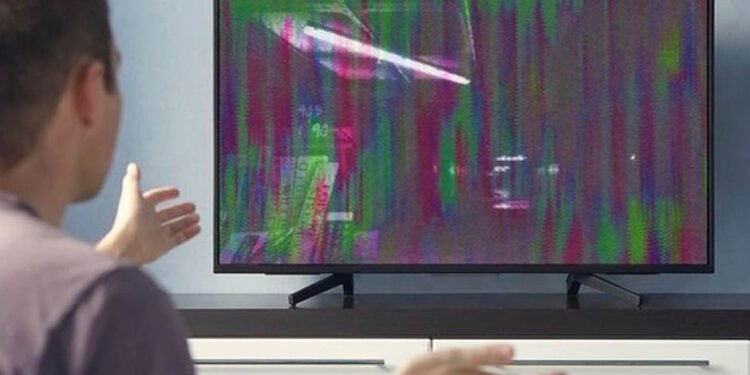Television screens have become integral to our daily lives, offering entertainment, information, and connectivity. However, screen flickering is a common issue that can disrupt our viewing experience. We will delve into the causes, effects, and solutions of TV screen flickering.
Understanding Screen Flickering
Screen flickering refers to the rapid and repetitive changes in brightness or color on a television display. This phenomenon can vary in intensity, from subtle, barely noticeable flickers to severe disruptions that make viewing difficult. Flickering can occur on various TV screens, including LCD, LED, OLED, and plasma displays.
Causes of TV Screen Flickering
- Refresh Rate Mismatch (60Hz vs. 120Hz)
One common cause of screen flickering is a mismatch between the TV’s refresh rate and the content being displayed. For instance, if a 60Hz TV is trying to display content originally designed for a 120Hz display, flickering may occur due to mismatched refresh rates.
- Interference from External Sources
External factors such as fluorescent lighting, nearby electronic devices, or even sunlight entering the room can cause interference and lead to screen flickering. Electromagnetic interference (EMI) from these sources can disrupt the TV signals, resulting in flickers.
- Faulty Cables or Connections
Poorly connected or damaged cables, such as HDMI or VGA cables, can also contribute to screen flickering issues. A loose connection or a damaged cable can disrupt the data flow between the TV and the external device, leading to intermittent flickers.
- Software or Firmware Issues
Sometimes, the software or firmware on the TV can be the culprit behind screen flickering. Software glitches, outdated firmware, or incompatible software updates can cause the display to behave erratically, including flickering.
Effects of Screen Flickering
The effects of screen flickering go beyond mere annoyance; they can impact the viewing experience and even cause discomfort or health issues. Prolonged exposure to flickering screens can lead to eye strain, headaches, and fatigue. It can also diminish the overall visual quality of the displayed content, affecting clarity and color accuracy.
Solutions to Screen Flickering
- Adjust Refresh Rate Settings
Check your TV’s refresh rate settings and ensure they match the content source. If possible, set the TV’s refresh rate to match the native refresh rate of the content, reducing the likelihood of flickering.
- Minimize External Interference
Identify and minimize external interference sources such as fluorescent lights, electronic devices, or sunlight. Positioning the TV away from such sources or using shielding materials can help reduce interference and mitigate flickering.
- Inspect and Replace Cables
Inspect the cables connecting your TV to external devices and ensure they are securely plugged in and not damaged. Replace any faulty wires to maintain a stable connection and prevent flickering due to connectivity issues.
- Update Software and Firmware
Please regularly update your TV’s software and firmware to the latest versions provided by the manufacturer. These updates often include bug fixes and optimizations that can address screen flickering issues caused by software or firmware glitches.
Impact of Screen Flickering on Gaming Experience
For avid gamers, screen flickering can significantly impact the gaming experience. A stable and flicker-free display is crucial for immersive gameplay, as flickers can cause distractions, reduce visual clarity during fast-paced scenes, and even lead to input lag. Gamers often prioritize displays with higher refresh rates (such as 120Hz or 144Hz) to minimize flickering and ensure smooth gameplay. Addressing screen flickering issues is paramount for gamers who want to enjoy their favorite titles without visual disruptions.
Professional Calibration and Adjustment
Professional calibration and adjustment may sometimes be necessary to resolve persistent screen flickering problems. Calibration specialists can fine-tune various display settings, including brightness, contrast, color balance, and refresh rates, to optimize the viewing experience and minimize flickering. While this option may incur additional costs, it can benefit users seeking precise and tailored solutions for their specific TV models and setups.
Long-Term Health Considerations
Beyond the immediate discomfort caused by screen flickering, there are potential long-term health considerations to be aware of. Prolonged exposure to flickering screens, especially at high intensities, can contribute to digital eye strain and exacerbate vision problems. Users need to take regular breaks, adjust display settings for optimal comfort, and consider using blue light filters or anti-glare coatings to reduce eye strain and minimize the impact of screen flickering on their eyesight over time. Prioritizing eye health using electronic devices is essential in today’s digital age.
Screen flickering on TV displays is a multifaceted issue with various causes, effects, and solutions. Whether it’s adjusting refresh rates, minimizing external interference, inspecting cables, updating software/firmware, or seeking professional calibration, users can take steps to mitigate flickering and enhance their viewing experience. For gamers, addressing flickering is crucial for seamless gameplay, while considering long-term health implications underscores the importance of ergonomic viewing practices. By proactively understanding and addressing screen flickering, users can enjoy more apparent, more comfortable, and visually engaging content on their TVs while safeguarding their eye health in the digital era.












